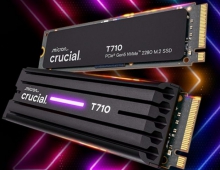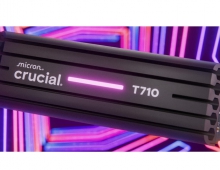Crucial MX500 500GB SSD review
1. Crucial MX500 - Micron's 64-layer NAND
Review Pages
2. Unboxing
3. HDTach, ATTO Disk Benchmark
4. CrystalDiskMark
5. AS SSD
6. IOMeter
7. Anvil Pro
8. PCMark 8, PCMark 7
9. Summary
Micron's new 64-layer NAND makes its way into the Crucial MX500 SSD, which launches with the promise to offer competitive performance and superior pricing.
The new SSD is based on Micron's second-gen TLC 3D NAND, which uses a 256Gbit die. This one is physically 30% smaller than the first generation, meaning that the memory maker could yield more die per wafer, with an apparent advantage in the overall cost. In addition, Micron says that new algorithms have been developed to improve performance by altering the way the data is distributed in the NAND cells.
The MX500 is marketed as an alternative to the Samsung 850 EVO. It comes in four capacities and two form factors. The 2TB model will only ship in the 2.5" form factor while the 250GB, 500GB, and 1TB models will come in both 2.5" and single-sided M.2 2280.
The MX500 uses the SMI SM2258 controller, which supports LDPC (Low-Density Parity-Check) error correction algorithms powerful enough for the new 64-layer 3D NAND.

Crucial MX500 SSD specifications:
- Form Factor: 2.5", M.2
- Capacity: 2TB (2.5” only) | 1TB | 500GB | 250GB
- Interface: SATA 6Gb/s
- Performance
- Sequential read: 560MB/s
- Sequential write: 510MB/s
- Random read: 95K IOPS
- Random write: 90K IOPS
- Endurance
- TBW: 700TB | 360TB | 180TB | 100TB
- MTTF: 1.8 million hours
- Warranty: 5-year limited
- Operating temperature: 0°C to 70°C
The MX500 supports 560/512 MB/s sequential read/write throughput. Random performance peaks at 95,000/90,000 read/write IOPS. Obviously, these performance figures depend on the application and the usage of the SLC caching technology, which increases TLC NAND's performance.
In terms of features the MX 500 Series offer self-encrypting drive (SED) and full disk encryption (FDE). Have in mind that you have to enable TCG/Opal or the ATA Security command via the system BIOS to take full advantage of the AES-256 encryption engine.
In order to protect your data from power failures, Micron has adjusted how it programs the upper and lower NAND pages to reduce the amount of power required to maintain signal integrity. So no extra capacitors are used, but Miron says that its approach offers similar protection to what we've seen with the MX series.
Crucial's Data Write Acceleration (DWA) uses an SLC buffer to boost the performance of the TLC SSD. While most SSDs have a fixed SLC capacity, Crucial's dynamic buffer shrinks or grows depending on the condition of the drive and the amount of data stored on the flash.
Accorrding to Micron, "the SSD firmware achieves acceleration through on-the-fly switching between SLC and TLC modes to create a high-speed SLC pool that changes in size and location with usage conditions."
"During periods of idle time between write bursts, the drive may free additional capacity for accelerated write performance. The amount of accelerated capacity recovered during idle time depends on the portion of logical addresses that contain user data and other runtime parameters. In applications that do not provide sufficient idle time, the device may need to perform SLC-to-TLC data migration during host activity."
The MX500 1TB will sell for $259.99. That's roughly $40 less than Samsung's 850 EVO 1TB.
Crucial ships the 2TB ($499.99), 1TB ($259.99), 500GB ($139.99), and 250GB ($79.99) models. The 2TB and 250GB models are much less expensive than the 850 EVO, but the 500GB model has a comparable price point and the 1TB model is roughly $40 cheaper than Samsung's 850 EVO 1TB.
Crucial matched the EVO's five-year warranty period, but the MX500 has a much higher endurance rating. You can write 700TB to the 2TB MX500 before exhausting the warranty, which is more than twice the 2TB EVO's endurance.
In the followign pafes we test the 500GB version of the Crucial MX500 SSD.
Review Pages
2. Unboxing
3. HDTach, ATTO Disk Benchmark
4. CrystalDiskMark
5. AS SSD
6. IOMeter
7. Anvil Pro
8. PCMark 8, PCMark 7
9. Summary





















